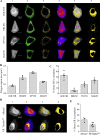A novel automated image analysis pipeline for quantifying morphological changes to the endoplasmic reticulum in cultured human cells
- PMID: 34496765
- PMCID: PMC8425006
- DOI: 10.1186/s12859-021-04334-x
A novel automated image analysis pipeline for quantifying morphological changes to the endoplasmic reticulum in cultured human cells
Abstract
Background: In mammalian cells the endoplasmic reticulum (ER) comprises a highly complex reticular morphology that is spread throughout the cytoplasm. This organelle is of particular interest to biologists, as its dysfunction is associated with numerous diseases, which often manifest themselves as changes to the structure and organisation of the reticular network. Due to its complex morphology, image analysis methods to quantitatively describe this organelle, and importantly any changes to it, are lacking.
Results: In this work we detail a methodological approach that utilises automated high-content screening microscopy to capture images of cells fluorescently-labelled for various ER markers, followed by their quantitative analysis. We propose that two key metrics, namely the area of dense ER and the area of polygonal regions in between the reticular elements, together provide a basis for measuring the quantities of rough and smooth ER, respectively. We demonstrate that a number of different pharmacological perturbations to the ER can be quantitatively measured and compared in our automated image analysis pipeline. Furthermore, we show that this method can be implemented in both commercial and open-access image analysis software with comparable results.
Conclusions: We propose that this method has the potential to be applied in the context of large-scale genetic and chemical perturbations to assess the organisation of the ER in adherent cell cultures.
Keywords: Automated image analysis; ER function; Endoplasmic reticulum morphology; High-content imaging.
© 2021. The Author(s).
Conflict of interest statement
The authors declare that they have no competing interests.
Figures






Similar articles
-
Dancing with the Stars: Using Image Analysis to Study the Choreography of the Endoplasmic Reticulum and Its Partners and of Movement Within Its Tubules.Methods Mol Biol. 2018;1691:75-102. doi: 10.1007/978-1-4939-7389-7_7. Methods Mol Biol. 2018. PMID: 29043671
-
High-content screening image dataset and quantitative image analysis of Salmonella infected human cells.BMC Res Notes. 2019 Dec 16;12(1):808. doi: 10.1186/s13104-019-4844-5. BMC Res Notes. 2019. PMID: 31843016 Free PMC article.
-
Quantitation of ER Structure and Function.Methods Mol Biol. 2018;1691:43-66. doi: 10.1007/978-1-4939-7389-7_5. Methods Mol Biol. 2018. PMID: 29043669
-
Subcompartments of the endoplasmic reticulum.Semin Cell Biol. 1992 Oct;3(5):325-41. doi: 10.1016/1043-4682(92)90019-r. Semin Cell Biol. 1992. PMID: 1457776 Review.
-
Taking organelles apart, putting them back together and creating new ones: lessons from the endoplasmic reticulum.Prog Histochem Cytochem. 2011 Jun;46(1):1-48. doi: 10.1016/j.proghi.2011.04.001. Epub 2011 May 4. Prog Histochem Cytochem. 2011. PMID: 21536318 Review.
Cited by
-
Fluorescence lifetime sorting reveals tunable enzyme interactions within cytoplasmic condensates.J Cell Biol. 2025 Jan 6;224(1):e202311105. doi: 10.1083/jcb.202311105. Epub 2024 Oct 14. J Cell Biol. 2025. PMID: 39400294 Free PMC article.
-
An Automated Imaging-Based Screen for Genetic Modulators of ER Organisation in Cultured Human Cells.Cells. 2024 Mar 26;13(7):577. doi: 10.3390/cells13070577. Cells. 2024. PMID: 38607016 Free PMC article.
-
ERnet: a tool for the semantic segmentation and quantitative analysis of endoplasmic reticulum topology.Nat Methods. 2023 Apr;20(4):569-579. doi: 10.1038/s41592-023-01815-0. Epub 2023 Mar 30. Nat Methods. 2023. PMID: 36997816
References
MeSH terms
Grants and funding
LinkOut - more resources
Full Text Sources
Research Materials

